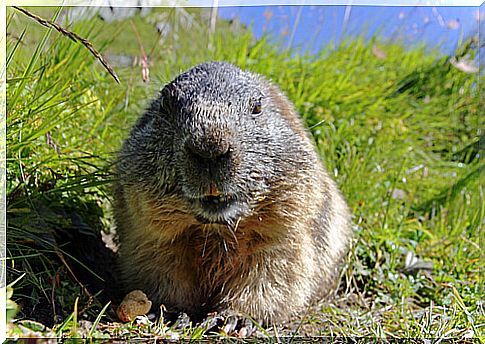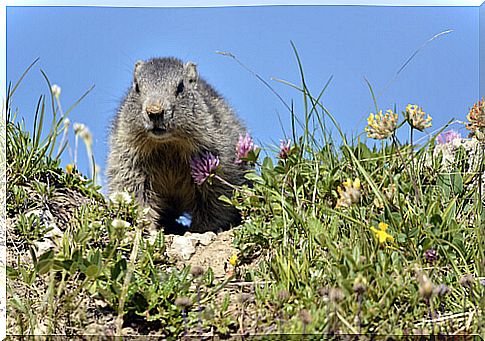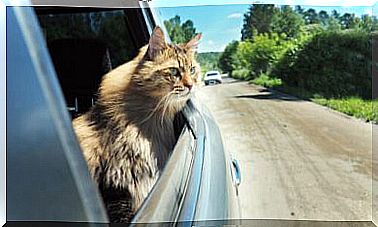Know The Habits Of The Alpine Marmot

This rodent is one of the largest in Europe and is related to squirrels, although their customs and aspects are different. In this article we inform you about the characteristics and habits of the Alpine marmot, which chooses its home at more than 800 meters high.
Characteristics of the Alpine marmot
To begin with, it is good to know that this rodent measures about 60 centimeters – plus 15 centimeters of tail, which is short compared to others in its family – and weighs a maximum of eight kilos. You can lose weight or gain weight depending on the time of year; it is heavier in fall and thinner in spring, after hibernating. After the beaver and the porcupine, the Alpine marmot is one of the largest rodents in Europe.
It has a robust head and body, short legs and very small ears that have adapted to the cold that is registered where they live. As for its fur, it is grayish brown on the back, yellowish on the belly and black on the tip of the tail. There is a subspecies whose hair is lighter.
Distribution of the Alpine marmot
Although from its name we can infer that the Alpine marmot is found in the Alps, it is also found in other mountain systems in the region : the Tatra Mountains and the Pyrenees. Their home is located between 800 and 3,200 meters above sea level.

According to fossil records, the Alpine marmot inhabited the area that includes present-day England and Russia for thousands of years. However, its population has been reduced due to the advance of man, climatic changes and poaching.
Although by the beginning of the 19th century the Alpine marmot was almost extinct, different measures helped prevent its disappearance. For example, since 1869 it cannot be hunted in the Tatras, and since the last century repopulations have been carried out in France, which have expanded to the French and Spanish Pyrenees.
This is because it is an adaptable and flexible species in terms of its food and shelter. The rapid expansion of the Alpine marmot is due to the climatic conditions of the region, to which it is accustomed.
Behavior and habits of the Alpine marmot
As with most of its relatives, the Alpine marmot is nocturnal and can spend hours searching for food during the day. When it does, it sits on its hind legs and takes food with its front legs, in a very characteristic posture.

In addition, it is a very sociable species and can form colonies of hundreds of specimens in the same large burrow, even if they are not related. The dens can be several meters deep and help them both to protect themselves from low temperatures in winter – including snowfall – and from attacks by carnivores.
Sometimes an Alpine marmot can be found at the entrance of the burrow, very alert to warn its companions about the appearance of danger. If this happens, it makes a very high-pitched screech that reaches the bottom of the shared cave.
Being a herbivore that forms nuclei of congeners, it impacts on the flora of the alpine meadows and is a prominent competitor for other species, such as the ptarmigan. However, it also offers its ‘benefits’ to the ecosystem, as it has become an easy prey to capture for predators such as the golden eagle and the fox.
In the fall they devour a large number of herbs and roots, and develop a thick layer of fat under their skin. During the winter season, the Alpine marmot hibernates: its body temperature drops more than seven degrees, its heart rate drops to 10 per minute, and its breath drops to three times every 60 seconds.









